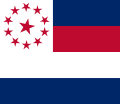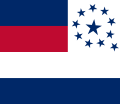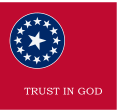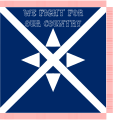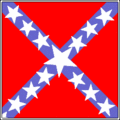Flag of Texas facts for kids
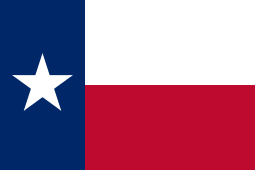 |
|
| Name | The Lone Star Flag |
|---|---|
| Use | Civil and state flag |
| Proportion | 2:3 |
| Adopted |
|
| Design | One-third of the hoist is blue containing a single centered white star. The remaining field is divided horizontally into a white and red bar. |
| Designed by | Unknown |
The flag of Texas is the official flag of the U.S. state of Texas. It's famous for its single white star, which gives it the nickname "Lone Star Flag." This star also led to Texas being called "The Lone Star State." People in Texas love their flag and show it great respect.
The Texas flag is one of only two U.S. state flags that used to be a national flag. The other is the flag of Hawaii. In 2001, experts on flags (called vexillologists) ranked the Texas flag as the second best design among all U.S. state, territory, and Canadian provincial flags. Only New Mexico's flag was ranked higher.
Contents
What the Texas Flag Looks Like
The law describes the Texas flag very clearly. It's a rectangle that is two parts wide for every three parts long.
Here's how it's designed:
- It has one blue stripe that goes up and down (vertical). This stripe is one-third of the flag's total length.
- There are two equal stripes that go across (horizontal). The top stripe is white, and the bottom stripe is red. Each of these stripes is two-thirds of the flag's total length.
- In the middle of the blue stripe, there's one white, five-pointed star.
- This star points straight up.
- The star is quite large. If you drew a circle through its five points, that circle would be three-fourths the width of the blue stripe.
History of the Flag
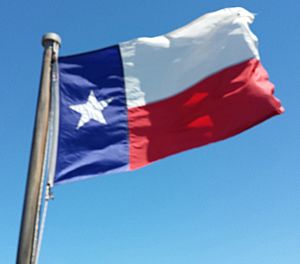
The idea for the flag was first brought up in the Congress of the Republic of Texas on December 28, 1838. It was officially adopted on January 25, 1839, to be the national flag of the Republic of Texas.
When Texas joined the U.S. as the 28th state on December 29, 1845, its national flag became the state flag. From 1879 to 1933, Texas didn't have an official state flag by law. However, the Lone Star Flag was still used by everyone during this time. It became official again with a new law in 1933.
No one knows for sure who designed the flag. Some people think Dr. Charles B. Stewart from Montgomery, Texas, might have designed it or drawn the picture used by the Congress. But his drawing looks very similar to an earlier drawing by Peter Krag.
Colors and What They Mean
The exact shades of red, white, and blue in the Texas flag are the same as those used in the flag of the United States.
| Color | Cable color | Pantone | Web color | RGB Values |
|---|---|---|---|---|
| Red | 70180 | 193 C | #BF0D3E |
(191,13,62) |
| White | 70000 | Safe | #FFFFFF |
(255,255,255) |
| Dark Blue | 70075 | 281 C | #00205B |
(0,32,91) |
The Texas Flag Code explains what the colors mean:
- Blue stands for loyalty.
- White stands for purity.
- Red stands for bravery.
The single "lone" star means "ALL of Texas." It shows that Texans are united as one for God, the state, and the country.
The idea of having one red and one white stripe actually comes from the short-lived Republic of Fredonia. This small state near Nacogdoches tried to break away from Mexico in 1826. Its flag used white and red stripes to represent the two groups of people who formed the state. Even though this rebellion failed, it inspired the later Texas Revolution.
The "lone star" symbol is even older than the flag itself. It was used to show that Texans were united in wanting independence from Mexico. A similar lone star was on the "Burnet Flag," which looked like the flag of the Republic of West Florida. Today, the "Lone Star" still represents Texas' independent spirit. It also gave the state its official nickname, "The Lone Star State."
Pledge and How to Display the Flag
The pledge of allegiance to the Texas flag is:
Honor the Texas flag; I pledge allegiance to thee, Texas, one state under God, one and indivisible.
The Texas Legislature created this pledge in 1933. In 2007, the words "one state under God" were added.
When you say the pledge, you should stand at attention with your right hand over your heart. If you are in uniform, you should give a military salute. In most schools across Texas, the Texas Pledge is said every morning after the Pledge of Allegiance to the American flag.
Texas law says the flag must be flown at state buildings on holidays and special occasions. It flies permanently above both doors of the Texas State Capitol. When the flag is displayed vertically, the blue stripe should be at the top. From your view, the white stripe should be to the left of the red stripe.
Historical Flags of Texas
National Flags Over Texas
-
1685–1689
French flag possibly used by René-Robert Cavelier, Sieur de La Salle -
1689–1785
Flag of New Spain -
1785–1821
Spanish state flag -
1821–1823
Flag of the first Mexican Empire -
1823–1836
First flag of the Mexican Republic -
1826–1827
Flag of The Republic of Fredonia -
1836–1839
The Burnet Flag, national flag of the Republic of Texas -
1839–1845/46
Republic of Texas national flag (identical to modern state flag) -
1846–1847
US flag when Texas joined the Union -
1861–1865
CS flag when Texas joined the Confederacy
Pre-Revolutionary Flags
-
Emerald flag of Augustus W. Magee and Bernardo Gutierrez's coup of 1812–13
-
1816–17 – Used by Louis-Michel Aury
-
1817–1821 – Used by pirate Jean Lafitte
Revolutionary Flags
During the Spanish Texas and Mexican Texas periods, and especially during the Texas Revolution, many different flags were used.
-
The Zavala Flag – Reportedly designed by Lorenzo de Zavala
The Lone Star and Stripes flag was used a lot by Texas land and naval forces. This flag looked like the U.S. flag but with a single star in the top left corner (called the canton). This design was similar to an earlier flag used by James Long in 1819 and 1821. There is evidence that the Lone Star and Stripes was used at famous battles like Goliad, the Alamo, and San Jacinto. It was also used when the first Congress of the Republic of Texas met in 1836.
Even though interim President David Burnet tried to make the Lone Star and Stripes the first official flag, it never became the legal national flag. However, it remained the naval flag of Texas until it joined the U.S. It was helpful because it looked so much like the U.S. flag. Despite not being official, this flag was well known as the symbol of Texas. The official blue and gold "Burnet Flag" was not as well known by Texans.
The "Come and Take It Flag" was made by the people of Gonzales. It showed a black five-pointed star and a picture of a cannon. Mexican forces had demanded they give up this cannon. At the Battle of Gonzales, a small group of Texans successfully fought off the Mexican forces. They made this flag as a sign of defiance.
The "Alamo Flag" or "1824 flag" was created by changing the Mexican flag. Instead of the eagle in the center, it had the year "1824." This showed support for the 1824 Constitution of Mexico, which Texans were fighting for. This was the first flag approved for use by Texas rebels. It's often said this flag flew at the Battle of the Alamo. However, this claim didn't appear until 1860, long after the battle. It's more likely that the "Alamo flag" mentioned at the time was the Lone Star and Stripes.
The Dodson Tricolor, or Dodson flag, was designed and sewn by Mrs. Sarah Dodson during the Revolution. It looked like the flag of Revolutionary France but had the Texas Lone Star in the top left corner. This flag flew over Texan forces and might have been the first Texas flag raised over San Antonio. It was also one of two flags that flew over the cabin where Texas delegates signed their declaration of independence.
Republic of Texas Flags
-

 1836–1839; 1839–1879
1836–1839; 1839–1879 
The Burnet Flag, national flag of the Republic of Texas -
1839–1845/46
The "Lone Star Flag", the Republic of Texas national flag
The Burnet Flag was adopted by the Texas Congress on December 10, 1836. It was named after David G. Burnet, who was the temporary president of the Republic of Texas. It was a blue flag with a large golden star, inspired by the "Bonnie Blue Flag" of the Republic of West Florida. Some versions of the Burnet Flag had a white star.
State Flags Over Texas
-
1845–present
Flag of the State of Texas as part of the United States
Secession Flags of Texas, 1861
In early 1861, when Texas left the U.S. but before it joined the Confederacy, an unofficial Texas flag was flown. It had fifteen stars, representing the fifteen slave states. No drawings of this flag exist, only descriptions.
Civil War Flags
Many flags were used by Texan soldiers during the American Civil War.
Centennial Flag of Texas, 1936
This flag was made for the Texas Centennial Exposition in 1936. This was a big fair in Dallas to celebrate 100 years of Texas independence.
Texas Flag Urban Legend

There's a common story that the Texas flag is the only state flag allowed to fly at the same height as the U.S. flag. This is an urban legend and is not true. The laws about Texas joining the U.S. don't say anything special about flags.
According to the United States Flag Code, any state flag can fly at the same height as the U.S. flag. However, the U.S. flag should always be on its own right side (which is your left when you're looking at them). The Texas Flag Code agrees with this. It says the state flag should fly below the U.S. flag if they are on the same pole. If they are on separate poles, they can fly at the same height.
Proposed Governor's Flag
The Texas governor currently uses a flag with the state's coat of arms. This coat of arms shows a lone star surrounded by oak and olive branches. It's on a light blue circle, which is on a dark blue flag with a white star in each corner. This flag has been used since the late 1960s or early 1970s, but it has never been officially adopted by law.
There were attempts in 2007 and 2009 to make the 1839 pilot flag of the Republic of Texas the official flag for the Governor. The 2007 bill didn't pass, and the 2009 bill passed the House but failed in the Senate. This was because it looked too much like the flag of Russia.
In 1993, changes to the Texas Flag Code allowed the Governor to choose their own flag. However, no governor has officially done this yet.
Similar Flags
The Texas flag looks similar to the flag of Chile, which was first used in 1817. The Chilean flag has a blue square in the top left corner with a white star. The Texas flag has a full blue stripe on the left side. Some people think both the Chilean and Texas flags were designed to look like the U.S. flag from far away at sea.
Many flags used by cities, counties, and other groups in Texas use a design similar to the Texas state flag.
See also
 In Spanish: Bandera de Texas para niños
In Spanish: Bandera de Texas para niños
- Symbols of the State of Texas
- Six flags over Texas
- World's Largest Texas Flag













































